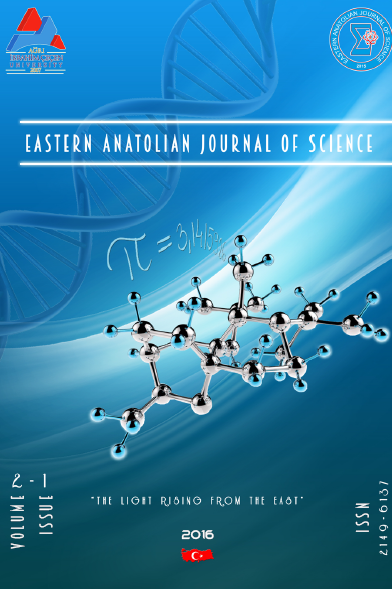The Synthesis and Applications of Dibromoisocyanuric Acid (DBI) in Chemical Reactions
The Synthesis and Applications of Dibromoisocyanuric Acid (DBI) in Chemical Reactions
Halogenated organic substrats are extremely important in chemistry due to their roles in organic synthesis as starting compounds. Bromination is one of the most important transformations in organic synthesis and can be carried out using molecular bromine or bromine carrying agents. Dibromoisocyanuric acid (DBI) is one of the bromine carrying agents that plays important roles in synthetic chemistry as an brominating agents and can bring about oxidations in organic molecules. In this minirewiev the synthetic methods of dibromoisocyanuric acid (DBI) and its roles in synthetic organic chemistry reported.
Keywords:
Dibromoisosyanuric acide, bromination oxidation,
___
- CHO, E., JAYARAMAN, A., LEE, J., KO, K. C., LEE, S. (2019). Substituent effect in the synthesis of α,α‐dibromoketones, 1,2‐dibromalkenes, and 1,2‐diketones from the reaction of alkynes and dibromoisocyanuric acid. Adv. Synth. Catal., 361,1846–1858.
- CHEUNG, Y.-F. (1979). N-bromosuccinimide: direct oxidation of aldehydes to acid bromides. Tetrahedron Lett. 20, 3809–3810.
- DE ALMEIDA, L. S., ESTEVES, P. M.,. DE MATTOS, M. C. S. (2006). Tribromoisocyanuric Acid: A New Reagent for Regioselective Cobromination of Alkenes, Synthesis , 2, 221.
- DIECK, H. A. and HECK, R. F., (1975). Palladium-catalyzed Conjugated Diene Synthesis of from Vinylic Halides and Olefinic Compound. J. Org. Chem., 40, 1083–1090.
- D’OYLEY, J. M., ALIEV, A. E., SHEPPARD, T. D. (2014). Regioselective Dihalohydration Reactions of Propargylic Alcohols: Gold-Catalyzed and Noncatalyzed Reactions Angew. Chem. Int. Ed. 53, 10747–10750.
- D’OYLEY, J. M., ALIEV, A. E., SHEPPARD, T. D. (2014). Regioselective Dihalohydration Reactions of Propargylic Alcohols: Gold-Catalyzed and Noncatalyzed Reactions. Angew. Chem. 2014, 126, 10923–10926.
- EISSEN, M. and LENOIR, D. (2008). Electrophilic Bromination of Alkenes: Environmental, Health and Safety Aspects of New Alternative Metots. Chem-Eur J.,14, 9830-9841.
- GIBSON, S. M., D’OYLEY, J. M., HIGHAM, J. I., SANDERS, K., LASERNA, V., ALIEV, A. E., SHEPPARD, T. D. (2018). Eur. J. Org. Chem. 4018–4028.
- GOTTARDI, W. (1967). Uber die reaktion von brom mit silbercyanuraten. Monatsh. Chem..,98, 1613–1617.
- GOTTARDI, W., (1968). Uber Bromierungen mit Dibromoisocyanursiiure unter ionischen Bedingungen, 1. Mitt: Monobromierungen Von. Monatsh. Chem. 99, 815–822.
- GOTTARDI, W., (1977).Zur chemic der bromisocyanursaure:Eigenschaften und reaktionen der dibromisocyanursaure Monatsh. Chem..,108, 1067–1084.
- GRIBBLE, G.W. (1996). Naturally occurring organohalogen compounds-A comprehensive survey. Prog. Chem. Org. Nat. Prod., 68, 1–496.
- GRIBBLE, G.W. (2010). Naturally occurring organohalogen compounds-A comprehensive update. Prog. Chem. Org. Nat. Prod. , 91, 1-613.
- GRIBBLE, G.W. (2012). Occurrence of halogenated alkaloids. In The Alkaloids: Chemistry and Biology; Knölker, H.-J., Ed.; Academic Press: Amsterdam, The Netherlands, 71,1–165.
- GRIBBLE, G.W. (2012). Recently discovered naturally occurring heterocyclic organohalogencompounds.Heterocycles, 84,157–207.
- GRIBBLE, G.W. (2015). Biological Activity of Recently Discovered Halogenated Marine Natural Products, Mar. Drugs,13, 4044-4136.
- GRONOWITZ, S., STENHAMMAR, K., SVENSSON, L. (1981). Lithiation of some 3[2-(2’-bromophenyl)ethyl]thiophenes and intramolecular transmetalation. Heterocycles 1981, 15, 947–959.
- JAYARAMAN, A., CHO, E., KIM, J., LEE, S. (2018). Decarboxylative Tribromination for the Selective Synthesis of Tribromomethyl Ketone and Tribromovinyl Derivatives. Adv. Synth. Catal. 360, 3978–3989.
- KANG, S., LA, M. T., KIM, H.-K. (2018). Convenient metal-free direct oxidative amidation of aldehyde using dibromoisocyanuric acid under mild conditions. Tetrahedron Lett., 59, 3541–3546.
- KWON, Y.-D., LA, M. T., KIM, H.-K. (2018). Aerobic oxidative esterification and thioesterification of aldehydes using dibromoisocyanuric acid under mild conditions: no metal catalysts required† New J. Chem. 42(13), 10833–10841.
- LUK’YANOV, O. A., POKHVISNEVA, G. V. TERNIKOVA, T. V. SHLYKOVA, N. I. (2012). 3,4-Bis(-nitroalkyl-ONN-azoxy)furazans and some of their derivatives. Russ. Chem. Bull.,Int. Ed. 2012, 61, 360–365.
- LUK’YANOV, O. A., POKHVISNEVA, G. V. TERNIKOVA, T. V. (2015). A novel method to access dinitromethyl-ONN-azoxy compounds. Russ. Chem. Bull. 64, 83–86.
- LUK’YANOV, O. A., POKHVISNEVA, G. V., TERNIKOVA, T. V. Russ. Chem. Bull. (2015). Nitro-substituted bis(methyl-ONN-azoxyfurazanyl)furoxans, 64, 137–141.
- MIYAURA, N., SUZUKI, A., (1979). Stereoselective Synthesis Of Arylated ( E )-Alkenes By The Reaction of Alk-1-Enylboranes with Aryl Halides In The Presence of Palladium Catalyst. J. Chem. Soc. Chem.Commun., 19, 866-867.
- NICOLAOU, K. C., BULGER, P. G., SARLAH, D. (2005). Palladium-Catalyzed Cross-Coupling Reactions in Total Synthesis, Angew. Chem. Int. Ed., 44, 4442 – 4489.
- PARAKHIN, V. V., LUK’YANOV, O. A. (2016). Synthesis of (α-nitroalkyl-ONN-azoxy)furoxan derivatives. Russ. Chem. Bull., 65, 295–297.
- PODGORŠEK, A., ZUPAN, M., ISKRA J. (2009). Oxidative Halogenation with “Green” Oxidants: Oxygen and Hydrogen Peroxide. Angew. Chem. Int. Ed. 2009, 48, 8424-8450.
- SEMENOV, S. E., CHURAKOV, A. M., LOFFE, S. L., VINOGRADOVA, E. A., ZLOTIN, S. G., LUK’YANOV O. A. (1991). Dibromoisocyanuric acid-A new reagent for the preparation of azo compounds from heterocyclic amines. Russ. Chem. Bull. 1991, 40, 1727.
- TAN, X., SONG, T., WANG, Z., CHEN, H., CUI, L., LI, C. (2017). Silver-Catalyzed Decarboxylative Bromination of Aliphatic Carboxylic Acids. Org. Lett.,19, 1634–1637.
- TOZETTI, S. D. F., DE ALMEIDA, L. S., ESTEVES P. M., DE MATTOS, C. S. M. (2007). Trihaloisocyanuric Acids/NaX: an environmentaly friendly system for vicinal dihalogenation of alkenes without using molecular halogen.. J. Braz. Chem. Soc., 18, 4, 675-677.
- VIRGIL, S. C. (2001). 1,3-Dibromoisocyanuric Acid. In Encyclopedia of Reagents for Organic Synthesis, (Ed. P. L. Fuchs), John Wiley & Sons.
- WILLIAM,J. M., KURIYAMA, M., OSAMU ONOMURA, O. (2014). Boronic acid-catalyzed selective oxidation of 1,2-diols to a-hydroxy ketones in water. Adv. Synth. Catal.,356,934-940.
- ISSN: 2149-6137
- Yayın Aralığı: Yılda 2 Sayı
- Başlangıç: 2015
- Yayıncı: Ağrı İbrahim Çeçen Üniversitesi
Sayıdaki Diğer Makaleler
Determination of Anti-genotoxic Properties of Baicalin by Comet Assay
The Hyperbolic Quadrapell Sequences
C-Scripter: A Dynamic Call Center Scripting Application
Mesut TARTUK, Taha Furkan NURDAĞ, Fatih ABUT, Fatih AKAY, Sevtap ERDEM
The Synthesis and Applications of Dibromoisocyanuric Acid (DBI) in Chemical Reactions
Hadamard Type Integral Inequalities for Differentiable (?, ?) −Convex Functions
